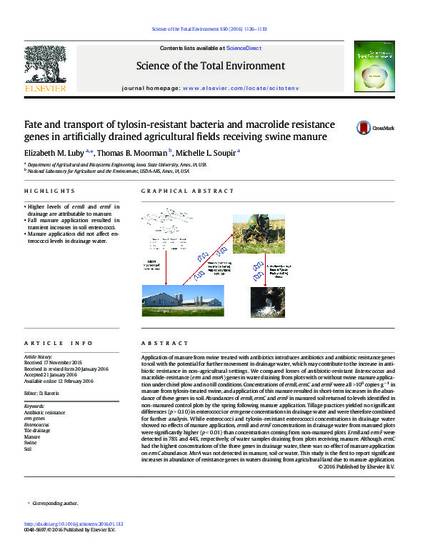
Application of manure from swine treated with antibiotics introduces antibiotics and antibiotic resistance genes to soil with the potential for further movement in drainage water, which may contribute to the increase in antibiotic resistance in non-agricultural settings. We compared losses of antibiotic-resistant Enterococcus and macrolide-resistance (erm and msrA) genes in water draining from plots with or without swine manure application under chisel plow and no till conditions. Concentrations of ermB,ermC and ermF were all > 109 copies g− 1 in manure from tylosin-treated swine, and application of this manure resulted in short-term increases in the abundance of these genes in soil. Abundances of ermB, ermC and ermF in manured soil returned to levels identified in non-manured control plots by the spring following manure application. Tillage practices yielded no significant differences (p > 0.10) in enterococci or erm gene concentrations in drainage water and were therefore combined for further analysis. While enterococci and tylosin-resistant enterococci concentrations in drainage water showed no effects of manure application, ermB and ermF concentrations in drainage water from manured plots were significantly higher (p < 0.01) than concentrations coming from non-manured plots. ErmB and ermF were detected in 78% and 44%, respectively, of water samples draining from plots receiving manure. Although ermC had the highest concentrations of the three genes in drainage water, there was no effect of manure application on ermC abundance. MsrA was not detected in manure, soil or water. This study is the first to report significant increases in abundance of resistance genes in waters draining from agricultural land due to manure application.
Available at: http://works.bepress.com/michelle_soupir/38/

This article is from Science of the Total Environment 550 (2016): 1126–1133, doi:10.1016/j.scitotenv.2016.01.132.